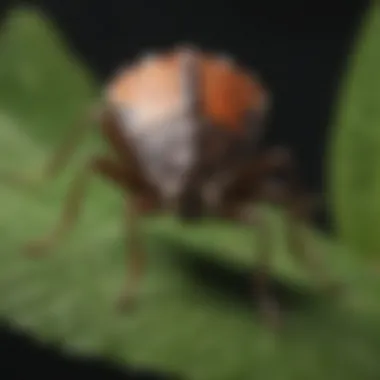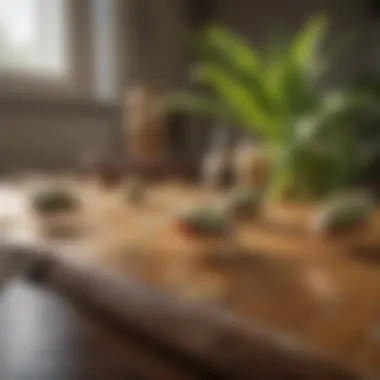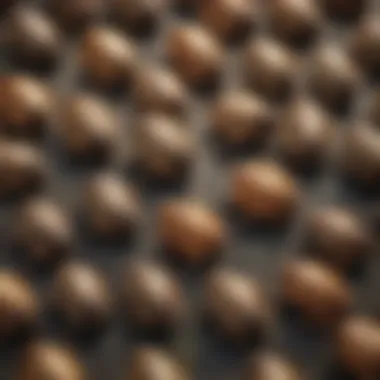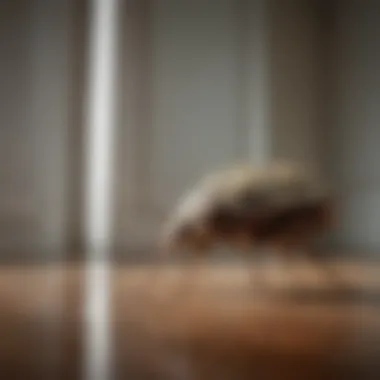Comprehensive Strategies to Deter Stink Bugs Effectively


Intro
Stink bugs have multiplied rapidly in various regions, leading to discomfort for homeowners. Understanding the underlying factors contributes to applying suitable methods for prevention and control. This article will cover essential characteristics of stink bugs, explore effective prevention strategies, and analyze control techniques for mitigating infestations.
Understanding the Pest
Identification
Stink bugs belong to the family Pentomidae. Identifying them accurately is vital for control efforts. They are typically shield-shaped, with a flat body and broad, rounded backs. The adults measure between 1/2 to 3/4 inches in length. Their coloration ranges from green to brown, and they are known for the distinct odor they emit when disturbed. Young bugs resemble adults but lack full color and size.
Life Cycle
The life cycle of stink bugs includes three stages: egg, nymph, and adult. Female stink bugs lay clusters of eggs on host plants, usually in spring. The eggs hatch into nymphs within a week. Nymphs go through five instars, gradually maturing into adults. This entire cycle may complete within a month, depending on environmental conditions. The season also affects behavior; in cooler months, stink bugs seek shelter indoors, making homes prime targets for infestations.
Pest Prevention Strategies
Environment Modification
To minimize stink bug presence, modification of the environment is key. Here are ways to achieve this:
- Seal Entry Points: Inspect homes for gaps in doors, windows, and siding. Use caulk or weather stripping to seal these openings.
- Reduce Attractants: Consider removing surrounding debris like piles of leaves or grass clippings. They often attract stink bugs.
- Choose Plants Wisely: Avoid planting crops that stink bugs prefer, such as tomatoes, peppers, and certain fruits.
Physical Barriers
Implementing physical barriers provides immediate solutions to prevent stink bugs from entering homes. These methods include:
- Insect Screens: Installing fine mesh screens on windows and doors can effectively prevent entry. Ensure they fit snugly and are free of holes.
- Traps: Create or purchase traps designed for stink bugs. They are an efficient way to capture them before they invade indoor spaces.
Control Methods
Chemical Control
While prevention is ideal, infestations may still occur. Chemical control offers various options:
- Insecticides: Targeted insecticides are effective against stink bugs. Brands like Talstar and Ortho provide formulations suitable for home use. Apply when stink bugs are active, preferably in the evening.
- Residual Sprays: These remain effective for several weeks. They can repel and kill if applied around suspected entry points.
Biological Control
Biological control involves the use of natural predators or parasites to manage stink bug populations. Options include:
- Beneficial Insects: Introduce predators such as wasps that prey on stink bug eggs. They help in reducing populations sustainably.
- Microbial Insecticides: Certain bacteria, like Bacillus thuringiensis, target specific pest species. It's eco-friendly and minimizes harm to other insects.
Integrating both prevention and control methods optimizes efforts in managing stink bug issues effectively.
Understanding Stink Bugs
Understanding stink bugs is essential for effective pest management. By comprehending their biological characteristics, life cycles, and common species, homeowners can proactively devise strategies to keep these pests at bay. Recognizing the behavior of stink bugs can aid in prevention, minimizing not just infestation but also the unpleasant odor they emit when disturbed.
Biological Characteristics
Stink bugs belong to the family Pentatomidae. They are typically characterized by their shield-like shape and can vary in color. Most commonly, their bodies are brownish or green, but some species exhibit vibrant hues. They have piercing-sucking mouthparts which they use to extract plant sap, causing significant damage to crops.
Their exoskeletons are relatively hard and can provide some protection against environmental factors. Stink bugs are also known for their distinctive odor, which they release as a defense mechanism. This aspect makes them particularly undesirable in homes, as the smell can linger and be hard to eliminate, thus understanding their biology is crucial for limiting their impact.
Life Cycle and Behavior
The life cycle of a stink bug consists of four stages: egg, nymph, juvenile, and adult. Female stink bugs lay clusters of eggs on the undersides of leaves. The eggs hatch into nymphs, which resemble smaller versions of the adults but without wings. Over several weeks, they molt multiple times before reaching adulthood.
Stink bugs are generally more active during late summer and fall, searching for suitable overwintering habitats. It is during this time that they often invade homes. Their behaviors are closely tied to temperature; as the weather cools, they will seek warmth and shelter, making residences a prime target. Understanding this cycle can help homeowners anticipate and mitigate possible infestations.
Common Species


Several species of stink bugs are commonly found across regions. The Brown Marmorated Stink Bug is perhaps the most notorious due to its invasive nature and its tendency to invade homes in large numbers during the fall months. Another common species is the Green Stink Bug, which also feeds on plants and crops.
Each species has unique behaviors and habitat preferences, yet all share similar patterns regarding their attraction to homes. It is essential for homeowners to identify which species are prevalent in their area to tailor their prevention strategies effectively.
Knowing the specific species can make a significant difference in pest management strategies.
Environmental Factors Contributing to Infestations
Understanding environmental factors is crucial for managing stink bug problems effectively. These pests thrive when certain conditions align, leading to increased infestations. Recognizing these factors allows homeowners to take preventative actions.
Seasonal Patterns
Stink bugs show distinct seasonal behavior that influences their activity levels. In spring, they emerge from winter hiding places, searching for warmth and food. As temperatures rise, their reproductive activities increase, leading to a surge in population. Late summer is when they become most problematic. During this time, they seek shelter in homes to escape the coming cold. Thus, knowing these seasonal patterns helps homeowners prepare in advance.
"Understanding the seasonal behavior of stink bugs can make a significant difference in how effectively you can deter them."
Habitat Preferences
Stink bugs prefer specific habitats that provide food and shelter. They are commonly found in agricultural areas, gardens, and landscapes with diverse plants. During nighttime, they hide in crevices and under foliage. By maintaining a less attractive environment, like reducing overcrowded plants or eliminating clutter, homeowners can limit stink bugs’ habitat. In addition, understanding their preferred environments can inform homeowners about strategic landscaping to minimize infestations.
Food Sources and Attraction
Stink bugs are omnivorous, feeding on a variety of plants. They are especially attracted to fruits, vegetables, and ornamental plants. Understanding which plants attract stink bugs can help homeowners make informed choices about their gardening. For instance, avoiding certain plants can reduce stink bug attraction and aid prevention. Additionally, the aroma of overripe fruits or decaying vegetation can draw them in. Keeping gardens well-maintained and removing potential food sources reduces the likelihood of infestations.
In summary, awareness of these environmental factors is vital for effective stink bug management. By understanding seasonal patterns, habitat preferences, and food sources, homeowners can develop strategies tailored to their specific situation, minimizing the risk of infestations.
Preventive Measures to Deter Stink Bugs
It is crucial for homeowners to implement preventive measures to deter stink bugs. Knowing what attracts these pests can significantly help in minimizing their presence. Effective strategies not only enhance comfort but also reduce the need for chemical treatments later. Focusing on preventive measures can save time, money, and effort while leading to a more sustainable home environment.
Sealing Entry Points
One of the first steps in pest control is sealing entry points. Stink bugs are highly skilled at entering homes through small cracks and openings. Common entry points include gaps in doors, windows, and even utility lines. By taking action to seal these areas, you establish a barrier against these nuisances.
Use materials like caulk or weather stripping to close gaps around windows. Inspect doors and identify potential spots for leaks. If necessary, consider adding screens to windows and vents to minimize chances of entry. This plan should be a routine practice, especially during autumn when stink bugs seek shelter indoors.
Proper Waste Management
Effective waste management plays a vital role in reducing attractants for stink bugs. They are often drawn to food waste, so managing garbage is essential. Regularly emptying trash bins and ensuring they are tightly sealed can decrease odors that attract pests.
Additionally, compost piles should be kept far away from the home and managed carefully. Maintaining a clean waste area reduces the chance of creating a favorable environment for these bugs.
Maintaining a Clean Environment
A clean home is less appealing to stink bugs. Regular cleaning routines contribute significantly to pest deterrence. Removing clutter, especially in areas where food is prepared or consumed, decreases hiding spots.
Consider vacuuming regularly and wiping down surfaces to keep them free of crumbs. Pay attention to areas around windows and baseboards, as these spots can easily become nests for unfortunate infestations. An organized and tidy living space not only creates a pleasant atmosphere but also contributes to effective pest control.
Indoor Plant Management
Houseplants can unintentionally attract stink bugs, so proper indoor plant management is necessary. Regularly check for any signs of pests on plants, as warm indoor conditions can encourage their activity. Use insecticidal soap or a solution of water mixed with dish soap to treat plants that show early signs of stink bug presence.
Avoid overwatering, as standing water attracts other pests that can become food sources for stink bugs. Additionally, position indoor plants away from windows where stink bugs may enter, thus reducing chances of invasion.
Natural Deterrents for Stink Bugs
Natural deterrents offer an eco-friendly and effective approach to keeping stink bugs at bay. They can provide safety to both the environment and to human inhabitants. In this section, we will delve into various natural options available to homeowners. Understanding these methods is crucial because they allow for pest control without harming beneficial insects or polluting the living space.
Essential Oils
Essential oils present a versatile method for repelling stink bugs. These concentrated plant extracts often have strong scents that are off-putting to many bugs. Oils such as peppermint, cedarwood, and lavender are particularly effective—each possessing unique properties that can deter stink bugs.
To utilize essential oils, mix a few drops with water in a spray bottle. Spray around entry points like windows and doors, or in areas where stink bugs tend to gather. This method not only helps to deter pests but also leaves a pleasant aroma in your home. Note that frequent reapplication may be necessary, especially after rain or cleaning.


"Using essential oils for pest control allows for a healthier living environment while effectively managing infestations."
Herbal Repellents
Certain herbs can act as natural repellents against stink bugs. Planting herbs such as basil, mint, and rosemary can create a barrier that deter these insects. Moreover, these plants can also serve dual purposes as culinary additions.
For maximum effectiveness, crush the leaves of these herbs and scatter them around infested areas. The strong scents released act as a natural repellent. Consider placing potted herbs near windows or doorways, which can enhance the aesthetic of your home while providing a defense against stink bugs.
Beneficial Insects Role
Encouraging beneficial insects in your garden can greatly aid in controlling stink bug populations. Predatory species, such as lady beetles and parasitic wasps, can naturally reduce the stink bug numbers through predation. To attract these insects, consider creating a diversified garden with native plants.
Planting flowers like marigolds or daisies not only adds beauty to your space but can attract beneficial insects. Installing insect hotels can also provide a habitat for many predatory species. A balanced ecosystem helps mitigate stink bug infestations naturally.
By employing essential oils, herbal repellents, and fostering beneficial insects, homeowners can effectively manage stink bugs without resorting to harsh chemicals. These methods not only protect your home but also promote a healthier environment.
Chemical Control Options
Chemical control options are vital in managing stink bug populations, especially when other methods may not suffice. These strategies offer a more immediate response to severe infestations. It is essential to understand the specifics of insecticides, their application techniques, and safety measures to ensure effective and responsible use.
Insecticides Overview
Insecticides designed for stink bug control are varied. These products may contain active ingredients such as pyrethroids, neonicotinoids, and insect growth regulators. Pyrethroids, like permethrin and cyfluthrin, are particularly effective due to their rapid action against a wide range of pests, including stink bugs. Neonicotinoids, such as imidacloprid, interfere with the insects’ nervous system, leading to quicker eradication.
When selecting an insecticide, consider the following:
- Target Species: Make sure the product specifically lists stink bugs
- Formulation Type: Options include sprays, granules, or bait stations
- Residual Effect: Some products offer longer-lasting protection than others, which can be beneficial for continued control.
Always read product labels for guidance on use and efficacy.
Application Techniques
Applying insecticides correctly is crucial for maximizing their effectiveness. Here are some key techniques:
- Spraying: For immediate problems, spraying walls, ceilings, and entry points can help reduce sightings. It is advisable to spray during the early morning or late afternoon when stink bugs are less active.
- Trenching: For outdoor applications, a trench application around the perimeter of your home can prevent stink bugs from entering.
- Bait Stations: These devices attract stink bugs and then kill them, providing a method of control that also reduces chemical exposure in living areas.
- Follow-Up Treatments: Regular monitoring and reapplication may be necessary to maintain control, depending on the level of infestation.
Always follow local guidelines and regulations when applying any pesticides.
Safety Precautions
Safety should always come first when working with chemicals. Here are recommended precautions:
- Personal Protective Equipment: Wear gloves, masks, and protective clothing to avoid skin contact and inhalation of insecticides.
- Ventilation: Ensure adequate ventilation during and after application, especially indoors. This helps to dissipate harmful vapors.
- Storage: Store insecticides in a cool, dry, and secure place, away from children and pets, to prevent accidental exposure.
- Field Research: Before using any chemical, consider researching local studies or guidelines to find the most effective and safest options for your region. Look into sources like Wikipedia or Britannica for accurate information.
By understanding chemical control options thoroughly, homeowners can effectively tackle stink bug infestations while navigating safety and efficacy.
Incorporating a thoughtful approach to chemical pest management ensures that homeowners can protect their living environments effectively.
Monitoring and Assessing Infestations
Monitoring and assessing infestations of stink bugs is critical for effective management. Understanding the presence and extent of these pests helps homeowners determine appropriate strategies to combat them before they become an overwhelming problem. Regular monitoring not only aids in early detection but also allows for timely intervention, which is often more effective than reactive measures. The benefits of vigilant monitoring can lead to lower pest populations and minimize damage in both outdoor and indoor environments.
Identifying Signs of Stink Bugs
Detecting stink bugs early is essential. Homeowners should be aware of the telltale signs that indicate an infestation. Look for:
- Visible Bugs: Adult stink bugs are shield-shaped and often found on the exterior walls of homes or in gardens.
- Egg Masses: These are usually found on the underside of leaves or on plants. They are spherical and can range from green to yellowish color.
- Foul Odor: When disturbed, stink bugs release a distinct, unpleasant smell. If there is a noticeable odor in specific areas, it may indicate their presence.
- Damage to Plants: Unexplained wilting or discoloration on plants can often point to feeding activity from stink bugs.
A proactive approach to inspecting properties regularly can help catch these signs, making management easier.
Tracking Seasonal Trends
Seasonal patterns play a significant role in the life cycle of stink bugs. They typically emerge in the spring, seeking food and shelter, and become more active during warm weather. Keeping track of these trends assists homeowners in preparing for potential infestations. During fall, stink bugs will look for entry points to shelter in homes as temperatures drop. It is beneficial to note:


- Emergence in Spring: Increased sightings of stink bugs indicate the need for preventive measures.
- Peak Activity in Summer: Homeowners should be more vigilant, checking for signs of infestation.
- Entry Strategies in Autumn: Ensure homes are well sealed to prevent these pests from entering.
By recognizing these seasonal behaviors, homeowners can not only anticipate stink bug activity but also develop tailored strategies for prevention and control.
Utilizing Traps Effectively
Trapping is a practical method for assessing and controlling stink bug populations. Several types of traps can be utilized:
- Commercial Sticky Traps: Available in stores, these can be placed around potential entry points and infested areas. Their bright colors attract stink bugs.
- Homemade Traps: A simple method can involve using soapy water in a container placed where stink bugs are commonly seen. The bugs are drawn in and cannot escape.
To maximize effectiveness:
- Strategically Place Traps: Position them near entry points, windows, and gardens.
- Check Regularly: Empty and replace traps as needed. This will provide insight into population levels and whether the strategies are working.
- Combine with Other Methods: Use traps in conjunction with sealing entry points and employing eco-friendly deterrents for optimal results.
"Monitoring and assessing stink bug populations is not simply about counting; it's about understanding patterns, addressing issues timely, and taking proactive steps to safeguard living spaces."
By focusing efforts on monitoring and trapping, homeowners can significantly reduce the nuisance and damage associated with stink bugs.
Collaboration with Pest Control Professionals
Effective management of stink bugs often requires more than just self-initiated efforts. The collaboration with pest control professionals plays a vital role in securing a long-lasting solution to infestations. Specialists not only come equipped with advanced tools and knowledge but also offer strategies that are tailored to specific environments. As sightings of stink bugs grow in numbers, relying on expert intervention can enhance the overall effectiveness of pest control efforts.
Evaluating Pest Control Services
When seeking pest control services, a meticulous evaluation is essential. It is crucial to assess multiple factors:
- Experience and Reputation: Look for companies with a solid reputation and years of experience in dealing with stink bugs. Customer reviews and testimonials serve as a good basis for judging effectiveness.
- Licensing and Certification: Ensure that the service providers have the necessary licenses and certifications as required by local regulations. This indicates their professionalism and adherence to safety standards.
- Customized Plans: A proficient pest control service should offer tailored treatment plans rather than a one-size-fits-all approach. Discuss their strategy for dealing with stink bugs and how it aligns with your specific needs.
Other considerations might include the company's response time, customer service approach, and warranty on their work.
Understanding Integrated Pest Management
Integrated Pest Management (IPM) is an essential aspect of professional pest control. It combines multiple strategies to minimize stink bug populations effectively while being environmentally responsible. The key components of IPM include:
- Monitoring: Regularly checking for signs of infestations helps to identify issues early and allows timely intervention.
- Prevention Techniques: This involves sealing entry points, managing landscaping, and utilizing repellents which are all part of an overall strategy to deter pests before they invade.
- Control Measures: When populations exceed acceptable levels, pest control professionals use targeted methods that focus on immediate removal while considering long-term effects on the environment.
Understanding IPM will guide homeowners to make informed decisions about pest control, ensuring harmony between effective management and ecological balance.
Long-Term Pest Management Strategies
For a permanent solution to stink bug issues, professional pest control services often advocate for long-term management strategies. These strategies focus on ongoing monitoring and treatment to maintain low pest populations:
- Regular Inspections: Scheduling seasonal inspections is crucial. These allow professionals to catch emerging problems before they escalate.
- Follow-Up Treatments: Implementing follow-up treatments can be necessary, especially in peak seasons when stink bug activity is high.
- Education and Awareness: Homeowners should be educated about identifying risk factors and recognizing signs of infestation early. Regular communication with pest control services can help reinforce best practices for prevention.
- Community Engagement: Collaborating with local communities on pest control efforts can amplify the benefits, as larger coordinated strategies often yield better results.
Community Awareness and Education
Community awareness and education are pivotal in combating the issue of stink bug infestations. Effective communication regarding the habits and life cycle of these pests can empower homeowners and families to take informed action. Raising awareness about stink bugs allows individuals to recognize the early signs of infestations and understand the best preventative measures.
Educating the community has several benefits. First, it strengthens the local response to pest issues through a collective effort. When people are informed about how to identify stink bugs and their habits, they can actively participate in prevention strategies. Second, community discussions can lead to shared experiences which foster a sense of collective responsibility in managing the environment.
Moreover, understanding the ecological impact of stink bugs and learning eco-friendly practices can lessen the negative repercussions of chemical treatments. This is increasingly important for maintaining ecological balance while still addressing pest control needs effectively.
"Knowledge empowers communities to face pest challenges together, creating sustainable solutions."
Local Outreach Programs
Local outreach programs play a critical role in community education. These initiatives can include informational sessions, public service announcements, or social media campaigns. Outreach programs create opportunities for residents to learn about stink bugs and engage in discussions about pest management strategies.
Getting the community involved can also lead to increased participation in preventative actions. For example, local organizations might host clean-up days where residents come together to clear potential stink bug habitats. Such initiatives promote unity while addressing pest problems directly.
Additionally, outreach programs can establish content tailored to specific regional challenges. Some areas may have a higher prevalence of particular stink bug species, and localized information can help residents prepare accordingly. By working together through outreach efforts, communities can bolster their defensive strategies against these pests.
Workshops for Homeowners
Workshops for homeowners provide an interactive platform to delve deeper into the specifics of stink bug management. These hands-on sessions can cover a variety of topics including identifying stink bugs, understanding their behavior, and implementing effective deterrents.
Conducting these workshops in an informal setting allows residents to ask questions and share experiences. Attendees can learn about best practices for sealing homes, maintaining gardens, and using natural repellents. Additionally, sharing success stories from neighbors can inspire action and foster a sense of community.
Homeowner workshops can also serve as a resource for demonstrating eco-friendly pest control solutions. Participants may appreciate practical demonstrations on how to prepare organic sprays and how to use traps effectively. Engaging the community through practical examples reinforces learning and promotes action.







